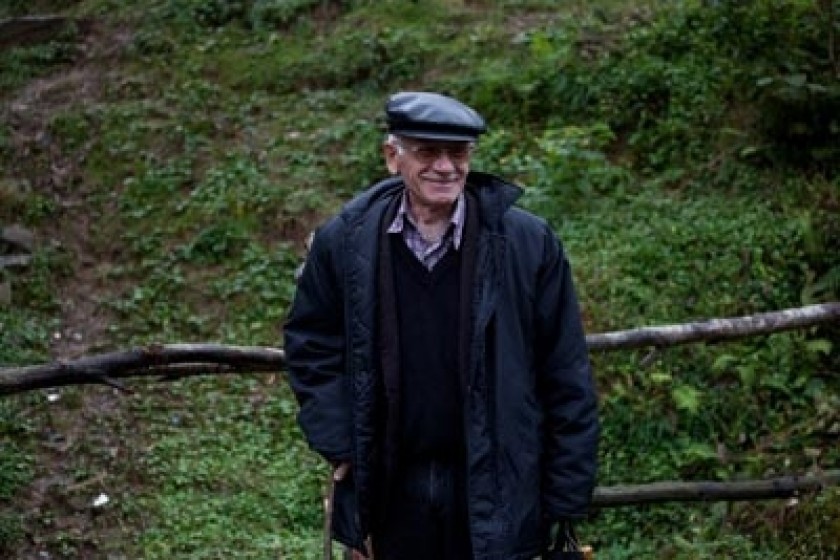
The Armenian-Speaking Muslims of Hamshen: Who Are They? (Part 2)
By Vahan Ishkhanyan
(Part 1)
Başoba: Armenian Songs and Strong Tea
Photo caption: Mukhi: It’s a very good thing being Hamshen, but being a Turk is also good. There’s no difference.
On the way up through the village, Harun stopped the car and picked up Mehmed who was returning from namaz prayer. “Yeah, he’s a good man but goes to the mosque to pray,” says Harun. Mehmed didn’t respond. But when Mehmed found out that we were from Armenia, he immediately remembered his army buddy. “I was serving in the army. One time, out of nowhere, a word in our language escaped my lips. The sergeant told me to say something else. I did. He then told me, ‘you’re my brother’. I was flabbergasted. Until then, I didn’t know what an Armenian was or that the language we spoke was Armenian. The sergeant, Kemal Çakız was from Istanbul. We remained friends for the rest of my army stint and keep in touch today.” (Armenians serving in the Turkish army change their names to avoid any unwanted repercussions.-author)
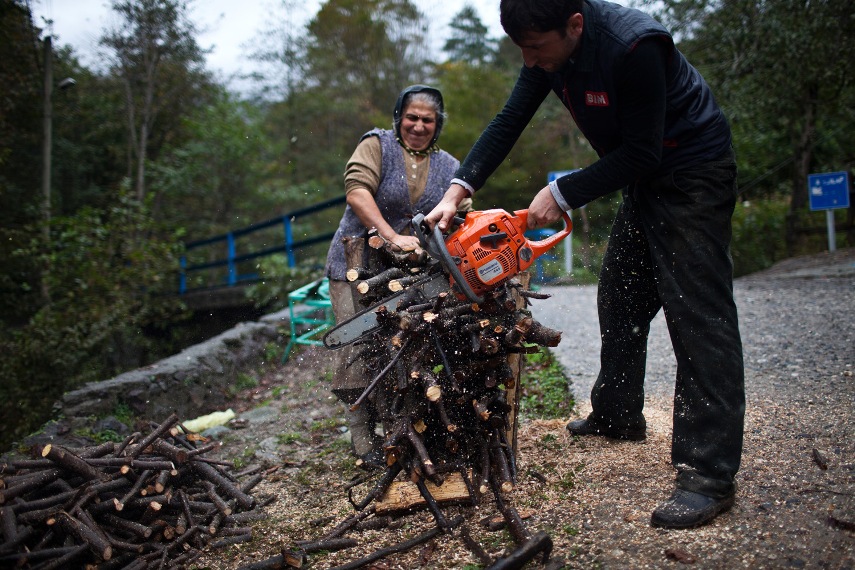 |
| Başoba: Lowering goods down the cliff by rope. This time winter firewood. |
Başoba (former Khigoba) is the village where Cemil and Harun Aksu were born. It’s the ancestral village of the Aksu family. Many believe that the Hopa-Hamshens originally lived in Başoba and later spread out to other villages. It’s a community of 250 homes – 2,000 residents in all of which 600 can vote. They’re all Hamshens. Harun’s wooden house is one of the oldest in the village – dating back some 160 years.
Mehmed, or Mukhi, the name he’s commonly called, has a work record covering all the main jobs of the Hamshens but one. He started out as a hoyiv (hoviv – shepherd) and moved on to become a bread-baker and then a worker in a tea factory. He’s yet to work as a freight driver.
We were greeted by Sevim, Mukhi’s wife. Upon entering the house, we took off our shoes and walked on the rugs inside. This is the custom in all Hamshen homes and throughout Turkey in general. (Even in Armenia, until the 1970s, there were homes in which slippers were placed at the door; a polite reminder to visitors to remove their shoes. My mother would tell visitors to our home who wanted to remove their shoes don’t to bother. Gradually, this custom faded away.- author)
Sevim sings in the Hamshen dialect:
Maa, aakak, maa / Sun, the time has come to set
Goungi mi dzovoun vaan / Don’t rest atop the sea
Yesa hedet egoghoum / I too will come with you
Goungadzim gharbis vaan / I stand on my word
There are other well-known Hamshen ditties where the word ander (forsaken/abandoned, itinerant/drifter) is the leitmotif. While there are Armenian and Turkish versions, the Armenian ander shows up in both.
Dere derunliğule ander / The stream, in its depth, ander
Irmak serunluğile ander / The river, in it coolness, ander
Yürüdün mü sevduğum ander / Did you walk, my dear, ander?
Yürüdün mü sevduğum / In the coolness of the morn, ander?
Ka ashoune kaana ander / Hey girl, when autumn comes, ander
Dondetsan khavogh kagha ander / Pick some grapes from the pear tree, ander
Da yes kezi arnogh chim ander / Boy, I won’t go with you, ander
Istersin ver-ver khagha ander / I don’t care what you do, ander
Anahit, with her professional photographic equipment, and I with my cell phone, record these Hamshen songs. The daughter-in-law serves tea, tea and more tea. It has to be the favorite drink along the Turkish sea coast. Walk into any store, even for a few minutes, and a glass of tea is set down before you – dark-bodied tea with a pleasing tang.
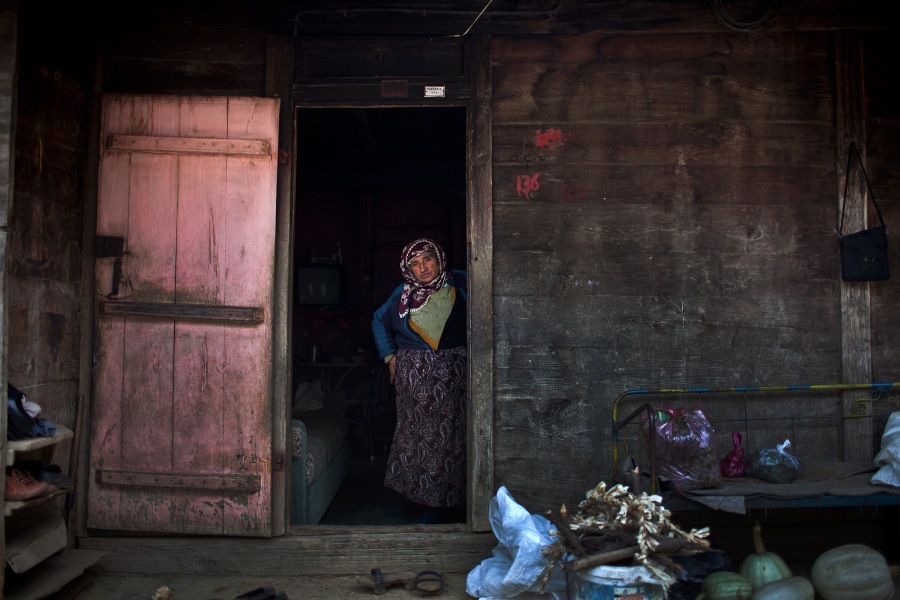 |
| Başoba: Old houses |
Sevim, 56, and Mukhi, 67, have five children; three boys and two girls. They’ve all married Hopa-Hamshens. One son lives in Çanakkale, near the Dardanelles; the other two in the town Hopa. One daughter has stayed in the village and the other resides in Kemalpaşa. It’s rare for a Hamshen to marry a Turkish speaker.
“In the past, it would be impossible for a Hamshen to marry an outsider. There were four daughters and three brothers in our family. My father kept us in the village and all of us married Hamshens,” says Sevim. “Today, times have changed. Outside marriages are possible.”
“If one of your relatives married an outsider, how would you react?” I ask Sevim.
“If they love one another let them marry, no problem,” she answers.
Sevim started to realize that she understood some words in the language I and Khachik were conversing in. One of the Hamshens asked if tea grows in Armenia. In my best Hamshen-like language I responded – che, chai menk chounink (no we have no tea). Sevim began to laugh. Menk chounink gosa, toun al Hamshen es (that’s how we say it, you too are Hamshen).
“Mukhi; who are the Hamshens?” I ask.
“It’s a very good thing being Hamshen, but being a Turk is also good. There’s no difference.”
Cemil chimes in, “We shouldn’t do like the Turks who force us to say in school that I am a Turk, I am righteous, a hard worker, that my main mission is to respect my elders, love children, etc. Hamshens prefer not to describe themselves.”
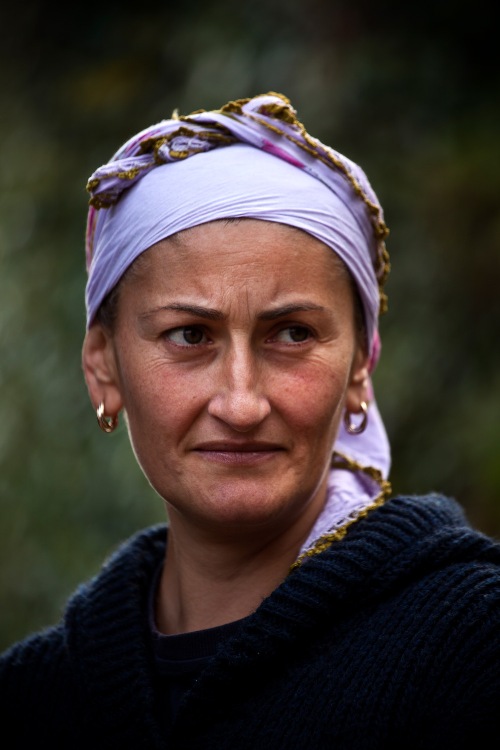 |
 |
| In Başoba | Hadji Süleyman: “We are Turks” |
Harun tells us that Mukhi’s father doesn’t speak Homshetsma because he considers it the infidel’s language. I ask if we can meet the father. They tell me that he’s sick in bed and doesn’t want strangers to see him in that state.
Thus, we decide to meet another village religious elder – Hadji Süleyman Cinkaya.
Hadji is the only male in the house. He’s lying on the bed. All the women are busy working as one.
“Eh...I walked up the ladder of life to the very top. Now I’m on the way down. Who knows how this story will end,” says Hadji Süleyman, slowly rising from the bed.
The man is between 90 and 100 years old. He can’t say for sure when he was born. All he remembers is that when the modern Turkish state was founded in 1923, he was about ten. Some officials came around asking for his birthday. They wrote something approximate down in the records.
Hadji Süleyman clearly recollects the most joyous days of his life, when he went to Mecca on pilgrimage. That was thirty years ago. He went by bus and it was packed. “I was the only one from our village. But there were five from Kemalpaşa, a few from Çavuşlu and one from Koyuncu (all Hamshen villages). I felt overjoyed to have gone.”
In bygone years, pilgrims would trek to Mecca on foot, battling the elements and the desert. Today, the preferred means is by bus.
Süleyman’s grandfather was also born in Başoba. As to what happened before, the old man talked about three brothers of the semi-legendary Galatal clan who migrated to the area and founded the village. One was short in stature and nicknamed Kota and his descendants are called kotayetsi. (I could find no information on the brothers or Galatal) In the end, the clan divided into ten sub-families, each having a mill.
Hadji Süleyman: “We are Turks”
On the way to Hadji’s house, Harun was saying, “Just watch. He’ll tell you that the Hamshens are a Turkish race from Central Asia who came here, interacted with Armenians, and learnt their language. That’s how it all happened. Only Süleyman doesn’t remember where they came from.”
When Hadji Süleyman found out that our Khachik was an Armenian from Istanbul, the old man took his hand in a warm embrace and began talking. “Ha, you’re from Stambul?” He didn’t even notice me giving questions to Khachik in a semi-familiar language to translate. Then he detected my presence, turned to me, and asked where I was from. When I answered, from Armenia, Hadji frowned. He turned away and continued his friendly conversation with Khachik.
“Fine, who are the Hamshens and where are they from?” Harun asks.
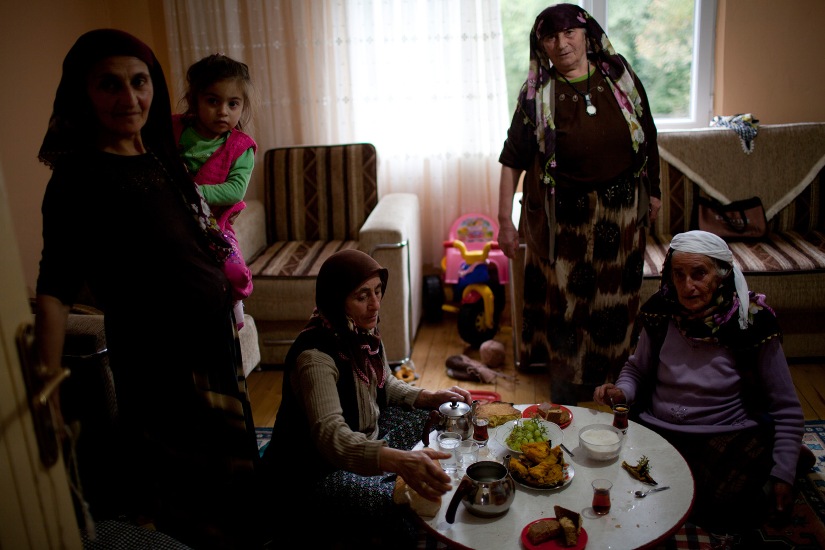 |
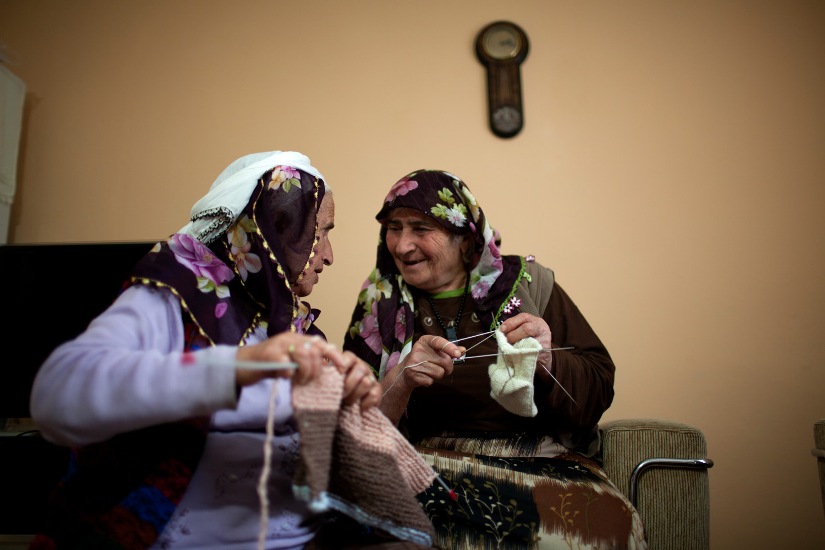 |
| Hadji Süleyman’s house |
|
Hadji related that a drought came over their country, forcing the inhabitants to leave. He said he can’t remember the name of the country, only that they when they reached Ardahan, a green and fertile land, they knew they had found a new home. Later, they moved to Çamlıhemşin, but much snow fell there as well. So they descended to the sea and much later came to these parts.
“Are you and the people of Çamlıhemşin the same?” I ask.
“Of course; we’re the same people.”
“Where does the Hamshen language come from?”
“We lived in the highlands, grazing sheep and goats. Those others (Hadji points to me and Khachik, i.e. Armenians) preferred to live on the coast. The Hamshens would cut wood and the Armenians would come and buy it. They were merchants. The others were skilled craftsmen and many Hamshens went to work for them. Thus, over time, we learnt Armenian. We took their language but that’s all. We aren’t Armenian but another race.”
- So what language did you speak before that - I ask.
- I can’t say what we spoke. We are a different race.
- Turkish?
- Hadji momentarily ponders my question and somewhat hesitatingly answers – Yes.
As we were leaving, Hadji held out the palms of his two hands firmly. “Let us forget whatever has happened, or not happened, between our two peoples in the past, so that we can now live as friends.”
***
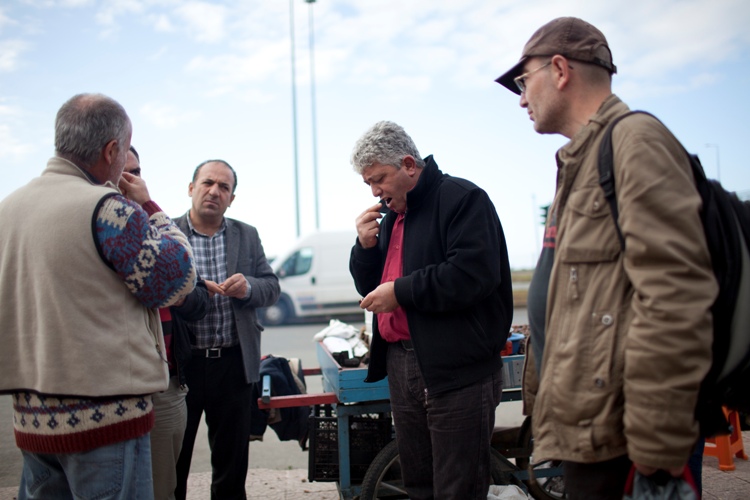 |
| Truck driver Aytekin: Give Karabakh back so that we can live together |
“Let me tell you something. Give Karabakh back so that we can live together,” says Aytekin, nibbling on chestnuts like they munch on sunflower seeds in Armenia. Walking through Hopa, we came across a group of people near a cart selling chestnuts. Learning that we were Armenian, they stopped us. They were Hamshen drivers and a few had been to Armenia. Aytekin has also driven freight trucks to Armenia and has picked up a smattering of the local lingo as a result. I buy a bag of chestnuts to munch on and the crowd gets bigger.
“How can we give Karabakh back? What about the people there?” I say.
“NO, no. Give it back so that this problem will end and we can live normally together.”
“And what nationality are you?”
“I’m a Turk,” says Aytekin without hesitation.
“So how come you speak in this language?”
“There were Armenians here in the past. We lived together, intermarried, and learnt the language.”
His friend, Ahmed, begins laughing.
“Why is it that we haven’t learnt normal Turkish till now, nor Laz? We only learnt Armenian.”
At this, another friend gets into the conversation,
“You got it all wrong. We knew this language all along. The Armenians learnt it from us.”
**********
Hamdi Yıldız, a former mullah, is sitting on the floor next to the stove. He’s complaining that moral standards are disintegrating. He talks about girls who have no shame wearing clothes that reveal their arms and legs, about men and women dancing together in locked embrace. Harun asks what the problem is and the man answers – temptation. Harun then asks if dancing pinky-to-pinky, Hamshen style, also isn’t enticing.
We go to attend a wedding in Çamurlu (formerly Çançağan), a village near Kemalpaşa. Everyone is speaking in Turkish at the house of Abdullah Yılmaz, as we wait for the ceremony when the bride to be taken away. Not one word in Hamshen. I’m constantly nudging Khachik to interpret.
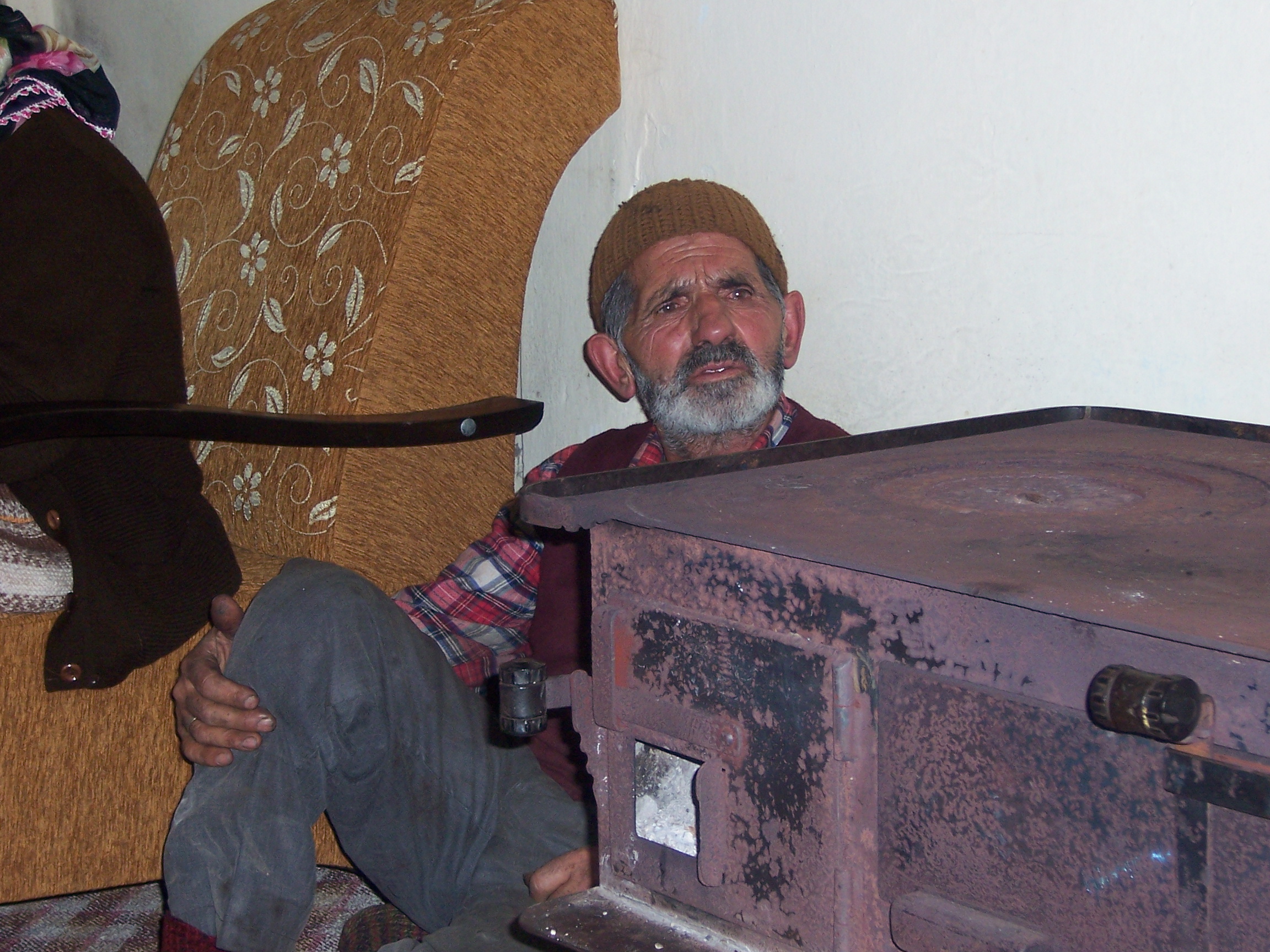 |
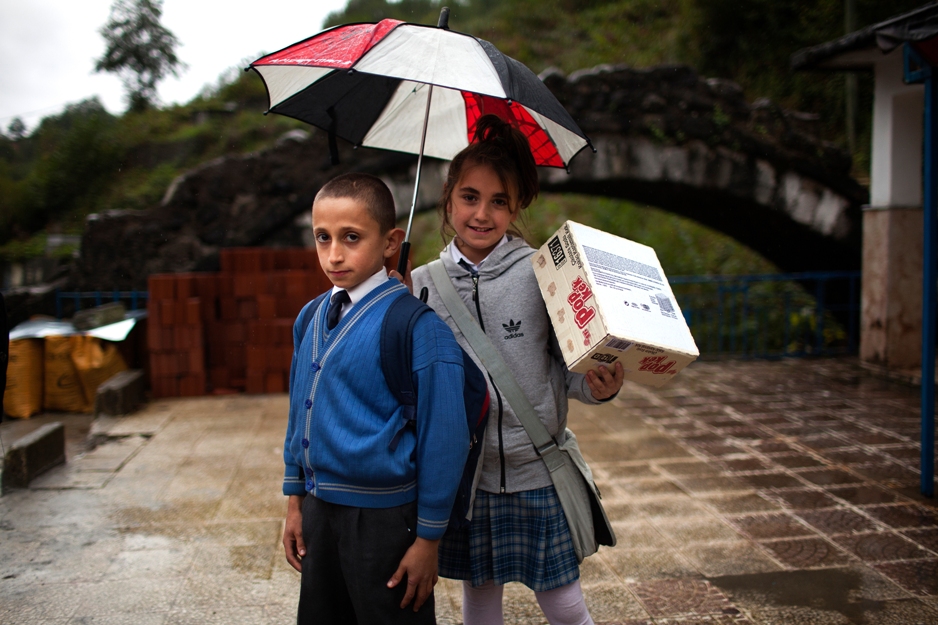 |
| Hamdi: No, we are not Armenian. We came from somewhere in Persia. |
Başoba |
“So what if we do a circle dance and my pinky touches that of my sister or someone else. It only expresses our closeness. Nothing more enters our mind,” says Harun.
The topic of conversation is about the origins of the Hamshens. While Harun and Yıldız are giving their version of Hamshen identity, homeowner Abdullah turns to me and says, “They talk a lot. Whether we’re Armenian or not it’s all the same. No one knows. In any case, we won’t leave this place.”
“No, we are not Armenian. We came from Persia and first lived in the mountains. Then we came down to this area,” says Hamdi.
“In reality, we are from a pure Turkish tribe,” says another, backing up what Hamdi just said. “There were three brothers in the beginning and one settled in Çamlıhemşin, one in Hopa and the other in Ardashen. Before that we lived in the Van region.”
“So what happened that we started to speak Hamshen?” Harun asks.
“We took girls from the Armenians as brides and learnt their language,” Hamdi says.
“We are neither Turks nor Armenians. We’re Hamshentsi”
| Harun Aksu: Hamshens are descended from Armenians but are now Hamshen. If someone says that Hamshens are Armenians and another that they are Turks, these two assertions merely melt the Hamshens. | 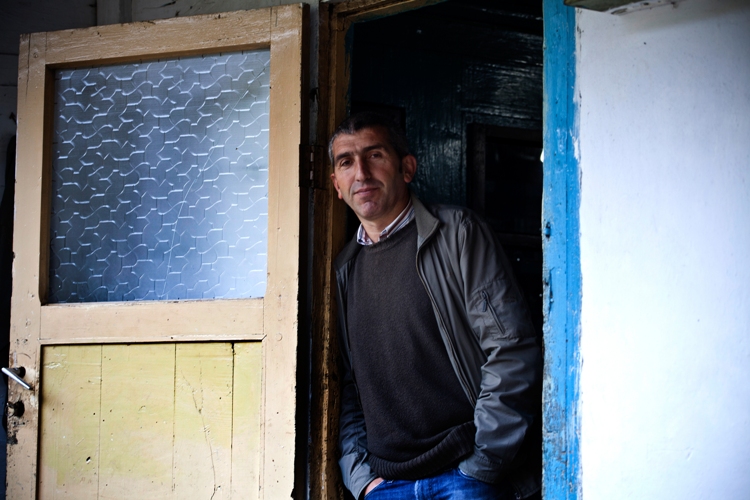 |
“For the past 40 years we’ve learnt Turkish. Before that, we didn’t know the language. How was it that, as Turks, we didn’t know Turkish but learnt Armenian?” Harun asks. Hamdi and the others listened in amazement. “It’s ridiculous to think that an entire people would change their language just by taking a few brides. True, we aren’t Armenian but Hamshens. We are, however, descended from Armenians. 400 years ago we were one and the same nation.”
On the last day before returning to Armenia, I ask Harun again – who are the Hamshens?
Here’s his response:
- Well, I tell both Armenian and Turkish nationalists that we, Armenians and Hamshens, were one tree and we turned into paper. That paper can burn and disappear. Hamshens are descended from Armenians but are now Hamshen. If someone says that Hamshens are Armenians and another that they are Turks, these two assertions merely melt the Hamshens. Given that historical records about the community and society are so scare, almost non-existent, a separate identity has evolved; that of the Hamshen.
- There are two types of Hamshen – Christian and Muslim. The Christians say they are Armenian. The Muslims regard themselves as Hamshentsi and that’s the view I support. It’s the paper I defend today, so it will not disappear. I do not want it to burn up. The tree wasn’t so threatened, but the paper is. A strong wind can blow it away. I am not against scientific research. The Armenians says this, the Turk say that. My overriding goal is to preserve the culture.
42 year-old Harun Aksu goes around archiving Hamshen songs, traditions, folklore, etc. He has a few published articles on the subject in the journal Bir Yaşam.
“Do you identify yourself with the Turkish-speaking Hamshens?” I ask.
“Yes, I identify with the Hamshens of Çamlıhemşin, Kyrgyzstan and Krasnodar. They are closely related. But I don’t identify with those from Abkhazia since we split apart a few hundred years ago. We don’t share the same values.”
“Why isn’t there any organized collaboration amongst Muslim Hamshens?”
“The more we become like those from Çamlıhemşin, we’re still far removed. Let’s face it, we split from them some 250 years ago.”
A Fading Legacy: The Hoyiv’s (Shepherds)
In Hopa’s Hayteh Bar the bartender pulls out a kaval (end blown flute; Armenian – bloul) from somewhere and hands it to Harun.
“I’ll tell you who’s a Hamshen. He’s a shepherd,” said Harun and begins to play the kaval. The shepherding past of the Hamshens lives on in the music only. Sitting in the bar drinking beer and rakı, (an anise-flavored hard alcoholic drink) Harun tells us about life in the mountains and the disappearing traditions of sheepherding.
And there’s also the circle dance. Every evening, in the Hayteh Bar’s smoky and dimly lit upstairs hall, young people noisily and energetically dance the horon, the mountain circle dance of their forefathers, to the accompaniment of kaval, bagpipe (tulum) and guitar.
The Hamshens were shepherds. What remains from that culture are the kaval music and the yayla – the summer traditional grazing areas up in the highlands where the Hamshens now go to beat the heat, rather than to graze livestock.
Large livestock farms have done away with the smaller flocks of the shepherds. The Hamshens have traded in their shepherd’s crock for the car wheel. Most of the men I met worked as drivers of one sort. Many are employed in tea production.
“There are large farms with 20,000 – 25,000 head of sheep. It no longer makes sense to raise animals,” says Kayaköy resident Cemal Vayiç who works at the Kemalpaşa tea factory.
Most of the villagers make a living from tea. Cemal tells me that the average annual revenue is about 15,000-20,000 Turkish lira (about $10,000).
Due to urbanization and modernization, from the 1960s onwards, many Hamshens started to move down into the towns (Kemalpaşa, Hopa) and then to the larger cities - Istanbul, Ankara, etc.
Population in the villages is decreasing from census to census. Today, many Hamshens have three residences – the yayla (former grazing lands), kegh-gyugh (place of birth) and charshi/tzap-dzovap (the city). (Çarşı means market/bazaar in Turkish)
Memories of the sheepherding past remain fresh amongst the elderly. Before that, the memories are sketchy. What were they doing before grazing sheep in the Artvin Mountains and why did the Hamshen people leave Hamshen proper for Hopa? Did they convert to Islam after arriving in Hopa or before? When did they arrive?
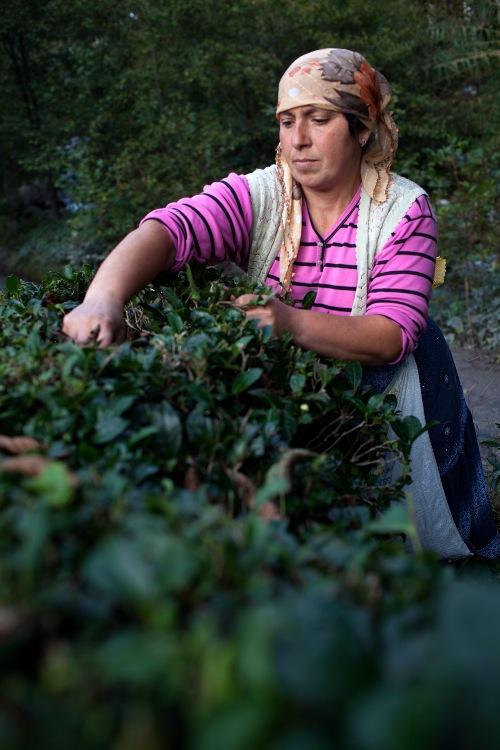 |
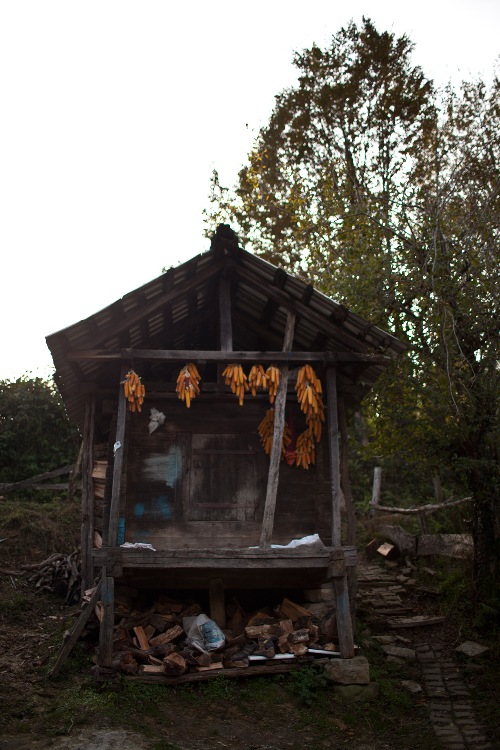 |
| Picking tea leaves | The granary of Harun Aksu |
On this topic Hovann Simonian writes:
- The date of the migration of the Hemshinli (Hamshens) to the districts of Hopa (Khopa, central district) and Makrial or Makriali (the present-day Kemalpaşa district of the Hopa county), to the east of Hemshin, remains unknown. According to T‘o˝lak‘yan, who estimates that 10 to 15 per cent of the total population of Hemshin moved to Hopa, the migration took place during the second half of the 17th century. The same approximate date is given by Minas Gasapian. ( Barunak Torlakyan, ‘Drvagner Hamshenahayeri Patmut‘yunits‘ ’ [Episodes from the History of Hamshen Armenians], 1981)
- Russian sources indicate a later date of settlement, around 1780 for N. N. Levashov, and the early nineteenth century for E. K. Liuzen. The latter was told in 1905 by an elderly Hemshinli woman that her ancestors had come to the Makrial district a century before. (N. N. Levashov, ‘Zamietka o pogranichnoi linii i zonie, na razstoianii ot berega Chernagomoria do goroda Artvina (s kartoiu)’ [A Note on the Border Line and Zone, from the Coast of the Black Sea to the City of Artvin; Tiflis, 1880)
- A second and more perplexing issue is whether these people were already converted to Islam or still Christians at the time of their settlement in Hopa. Written and oral sources fail to provide any answer to this question.
- A study published recently in Turkey advances a radically new hypothesis on the question of the date of the migration to Hopa and the period of conversion of the Hopa Hemshinli. According to the author, Ali Gündüz, the migration took place in the early sixteenth century, during the reign of Ottoman Sultan Selim I. The Hemshinli, who were then still Christians, were settled as timariots (fief holders) in this borderland district to defend it against ‘Georgian and Abaza pirates’. Conversion would have taken place some 200 years later, at the beginning of the eighteenth century. (Ali Gündüz, Hemşinliler: Dil – Tarih – Kültür (Ankara: Ardanuç Kültür Yardımlaşma Derneai, 2002)
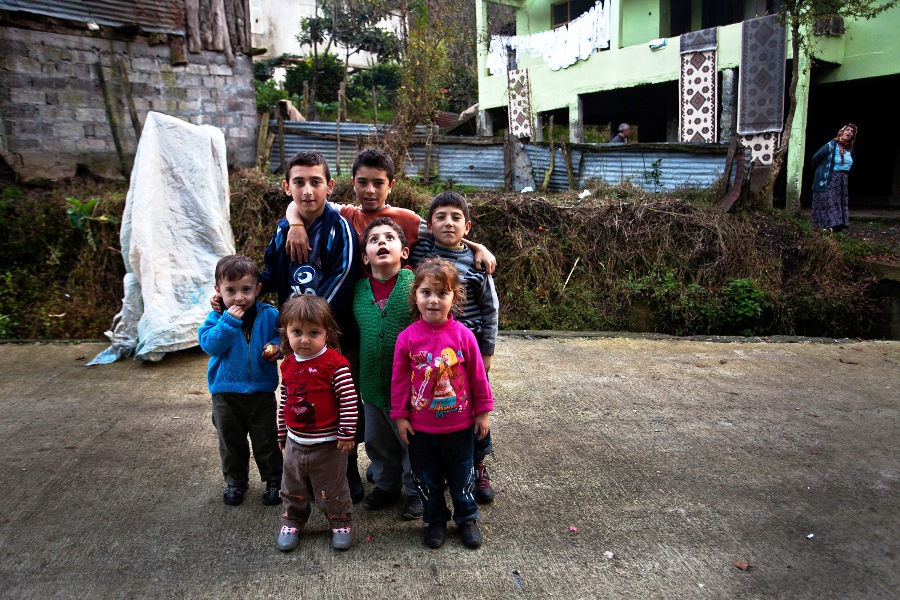 |
| Çamurlu |
- However, aside from the author’s failure to provide any proof to substantiate his claims, this theory, although interesting, presents a few problems. The first is that, with the exception of a small hamlet – now disappeared – called Little Hemshin, there are no Armenian toponyms in Hopa and Makrial, but only Lazi and Turkish ones, which would tend to indicate a relatively recent date of migration.
- The second is that unlike their Laz, and particularly Ajar neighbors – whose warlike character was widely reported – little is known about any military tradition among the Hopa Hemshinli. Had Hemshinli timariots existed in Hopa they would have probably evolved, like timar holders elsewhere in the Pontos, into derebeys towards the end of the seventeenth century, following the breakdown of central administration. Yet Hemshin derebeys or aghas are unheard of in Hopa, where Hemshin appeared to have been relatively poor and not to have owned much land. In an early twentieth century article on the region, they are described as tilling fields belonging to the Laz.
- It was not for being wealthy landowners, but for their activity as pastoralists and their practice of transhumance, that Hopa Hemshinli were mostly known in nineteenth-century reports by Russian and other European travelers. In the summer, they took their flocks to yaylas located in the Vavvet area, relatively far from their villages. The men dressed like Ajars, with turbans wrapped around their heads, while women dressed similarly to Kurds. According to Liuzen, they were taken for Kurds throughout the entire Artvin region because of their way of life, and people were surprised to learn that they spoke Armenian. (Liuzen “Bereg Russkago Lazistana”):
- According to an article published in 1888, the Hopa Hemshin numbered 600 households, divided between 423 families in Turkey and 177 in Russia – compared to a figure of around 2,200 households for the traditional, or Bash Hemshin area.
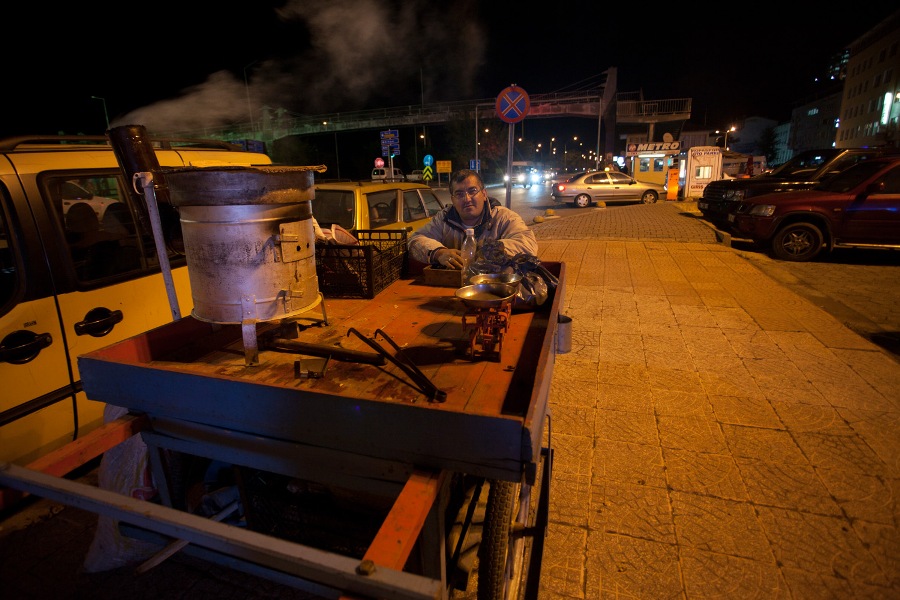 |
| Hopa chestnut seller |
- It is likely that this marginal existence as pastoralists allowed for the survival of the Armenian language in the Hopa/Makrial region. The Hopa Hemshinli were too unimportant to be a cause of worry, and they were certainly not worth the same type of government pressure – involving the opening of Turkish schools and missionary activity by mullahs – that contributed to the abandonment of Armenian in Karadere. In addition, provincial secular and religious authorities, as Russian officials in later times, may simply not have been aware of or even have suspected that this small Muslim community, which some believed to be Kurdish, was actually Armenian speaking. A second possible reason for the preservation of the Armenian language lies in the absence of economically induced migrations among the Hopa Hemshinli, who did not share the economic mobility of their compatriots in Bash Hemshin (i.e. Hemshin proper, to distinguish the original Hemshin district from Hopa Hemshin).
- An estimated 200 Hopa Hemshin households in the vicinity of Makrial (now Kemalpaşa) passed under the dominion of Tsarist Russia as a result of the 1877-78 Russo-Turkish War. Thus, for the first time since the Ottoman conquest in the 1480s, a number of the descendants of Hamshen Armenians found themselves under the rule of a Christian power. In the following years, however, the Hamshen made no attempt to return to their former religion. This is probably explained by the fact that they had converted to Islam much earlier.
- It is also interesting to examine the attitude of the Armenian Church and Armenian society in general regarding Islamicized Armenians. In 1887, Grigor Artsruni, the renowned publisher of the Tiflis Armenian language newspaper Mshak, chastised Armenian Church authorities in an editorial for their carelessness and indifference towards Islamicized Armenians. He invited the Armenian Church to establish a missionary organization to work with the Islamicized Armenians of the regions annexed to Russia in 1878.Yet his demands went unheeded, and the Armenian Church made no effort to proselytize among Muslims of Armenian extraction.[1]
Haykazoun Alvrtsyan, Director of the Western Armenian Research Center, told me that the Hopa-Hamshens retained their dialect due to their incorporation into the Russian Empire.
(to be continued)
Khachatur Terteryan assisted in the research work.
Photos by Anahit Hayrapetyan
Translated by Hrant Gadarigian
[1] “The Hemshin: History, society, and identity in the Highlands of Northeast Turkey”, Edited by Hovann H. Simonian (Routledge, London and New York, 2007)
 Videos
Videos Photos
Photos




Comments (15)
Write a comment